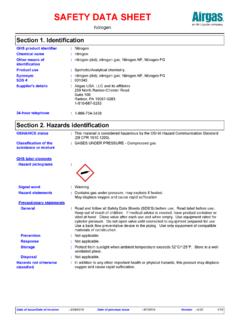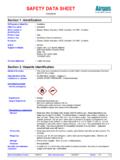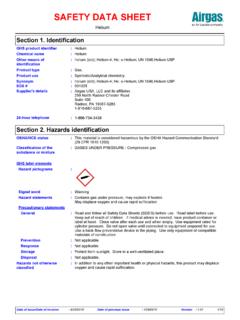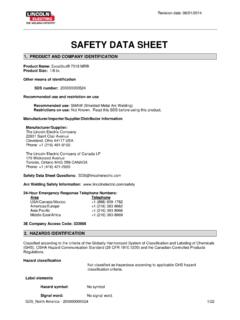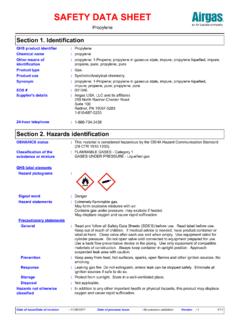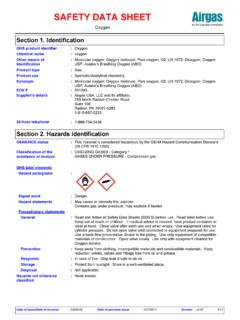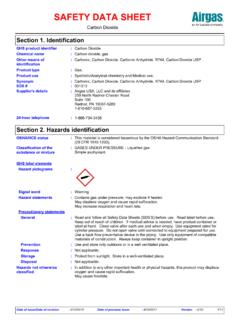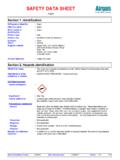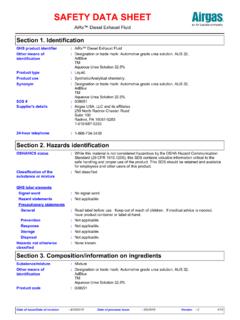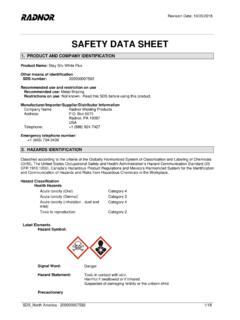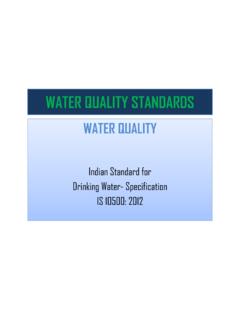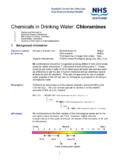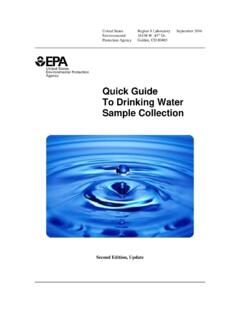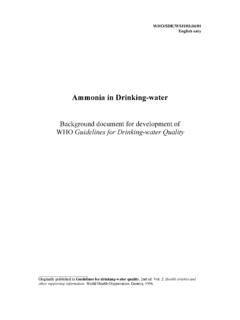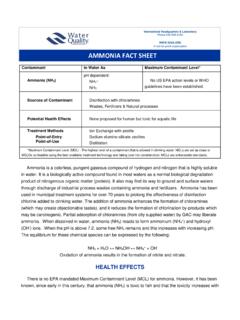Transcription of SAFETY DATA SHEET - Airgas
1 Ammoniaammonia; anhydrous data SHEETGHS product identifierOther means of identificationProduct typeSection 1. Identification:::Chemical name:ammoniaSupplier's details:AmmoniaProduct use:Synthetic/Analytical : ammonia ; anhydrous ammoniaSDS #:001003 Airgas USA, LLC and its affiliates259 North Radnor-Chester RoadSuite 100 Radnor, PA 19087-52831-610-687-52531-866-734-3438:2 4-hour telephoneSection 2. Hazards identificationFLAMMABLE GASES - Category 2 GASES UNDER PRESSURE - Liquefied gasACUTE TOXICITY (inhalation) - Category 4 SKIN CORROSION - Category 1 SERIOUS EYE DAMAGE - Category 1 AQUATIC HAZARD (ACUTE) - Category 1 Classification of the substance or mixture:Signal word:DangerHazard statements:Flammable form explosive mixtures with gas under pressure; may explode if displace oxygen and cause rapid if severe skin burns and eye toxic to aquatic pictograms:Precautionary statementsPrevention:Wear protective gloves.
2 Wear eye or face protection. Wear protective clothing. Keep away from heat, hot surfaces, sparks, open flames and other ignition sources. No smoking. Use only outdoors or in a well-ventilated area. Avoid release to the environment. Avoid breathing gas. Wash hands thoroughly after label elementsGeneral:Read and follow all SAFETY data Sheets (SDS S) before use. Close valve after each use and when empty. Use equipment rated for cylinder pressure. Do not open valve until connected to equipment prepared for use. Use a back flow preventative device in the piping. Use only equipment of compatible materials of construction.
3 Always keep container in upright position. Approach suspected leak area with status:This material is considered hazardous by the OSHA Hazard Communication Standard (29 CFR ).Date of issue/Date of revision:1/10/2019 Date of previous issue:10/9/2018 2. Hazards identificationResponse:Collect spillage. IF INHALED: Remove person to fresh air and keep comfortable for breathing. Immediately call a POISON CENTER or physician. IF SWALLOWED:Immediately call a POISON CENTER or physician. Rinse mouth. Do NOT induce vomiting. IF ON SKIN (or hair): Take off immediately all contaminated clothing.
4 Rinse skin with water or shower. Wash contaminated clothing before reuse. Immediately call a POISON CENTER or physician. IF IN EYES: Rinse cautiously with water for several minutes. Remove contact lenses, if present and easy to do. Continue call a POISON CENTER or physician. Leaking gas fire: Do not extinguish,unless leak can be stopped safely. Eliminate all ignition sources if safe to do :Store locked up. Protect from sunlight. Store in a well-ventilated :Dispose of contents and container in accordance with all local, regional, national and international not otherwise classified:In addition to any other important health or physical hazards, this product may displace oxygen and cause rapid 3.
5 Composition/information on ingredientsammonia1007664-41-7 Ingredient nameCAS number%There are no additional ingredients present which, within the current knowledge of the supplier and in the concentrations applicable, are classified as hazardous to health or the environment and hence require reporting in this name:ammoniaOther means of identification: ammonia ; anhydrous ammoniaCAS number:7664-41-7 Substance/mixtureCAS number/other identifiers:Occupational exposure limits, if available, are listed in Section concentration shown as a range is to protect confidentiality or is due to batch code:001003As this product is a gas, refer to the inhalation section.
6 Immediately flush eyes with plenty of water , occasionally lifting the upper and lower eyelids. Check for and remove any contact lenses. Continue to rinse for at least 10 minutes. Get medical attention immediately. Call medical doctor or poison control center burns must be treated promptly by a contaminated skin with plenty of water . Remove contaminated clothing and shoes. To avoid the risk of static discharges and gas ignition, soak contaminated clothing thoroughly with water before removing it. Continue to rinse for at least 10 minutes. Get medical attention immediately.
7 Call medical doctor or poison control center immediately. Chemical burns must be treated promptly by a physician. Wash clothing before reuse. Clean shoes thoroughly before victim to fresh air and keep at rest in a position comfortable for breathing. If it is suspected that fumes are still present, the rescuer should wear an appropriate mask or self-contained breathing apparatus. If not breathing, if breathing is irregular or if respiratory arrest occurs, provide artificial respiration or oxygen by trained personnel. It may be dangerous to the person providing aid to give mouth-to-mouth resuscitation.
8 If unconscious, place in recovery position and get medical attention immediately. Maintain an open airway. Loosen tight clothing such as a collar, tie, belt or waistband. Get medical attention immediately. Call medical doctor or poison control center case of inhalation of decomposition products in a fire, symptoms may be exposed person may need to be kept under medical surveillance for 48 4. First aid measuresEye contactSkin contactInhalationIngestion::::Descriptio n of necessary first aid measuresDate of issue/Date of revision:1/10/2019 Date of previous issue:10/9/2018 4.
9 First aid measuresProtection of first-aiders:No action shall be taken involving any personal risk or without suitable training. If it is suspected that fumes are still present, the rescuer should wear an appropriate mask or self-contained breathing apparatus. It may be dangerous to the person providing aid to give mouth-to-mouth resuscitation. Wash contaminated clothing thoroughly with water before removing it, or wear to physician:In case of inhalation of decomposition products in a fire, symptoms may be exposed person may need to be kept under medical surveillance for 48 treatments:No specific important symptoms/effects, acute and delayedInhalation:Harmful if this product is a gas, refer to the inhalation section.
10 :IngestionSkin contact:Causes severe serious eye damage.:Eye contactOver-exposure signs/symptomsSkin contactIngestionInhalationNo specific symptoms may include the following:, stomach painsAdverse symptoms may include the following:, pain or irritation, redness, blistering may occur:::Eye contact:Adverse symptoms may include the following:, pain, watering, rednessPotential acute health effectsSee toxicological information (Section 11)Indication of immediate medical attention and special treatment needed, if necessaryFrostbite:Try to warm up the frozen tissues and seek medical 5.
